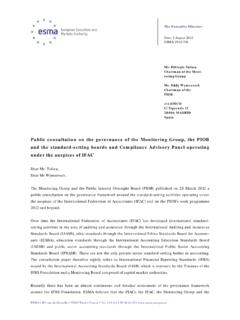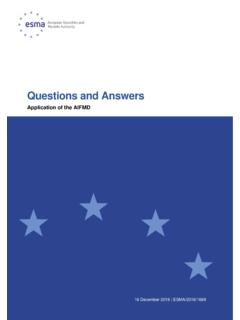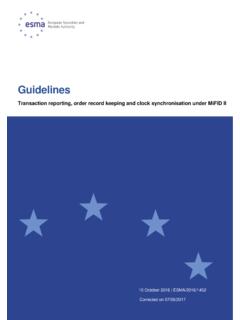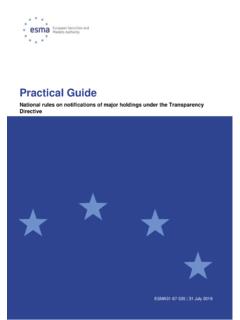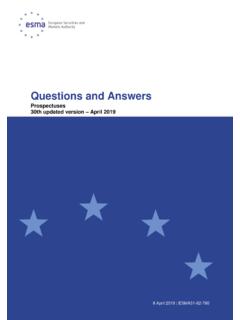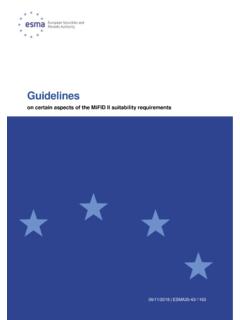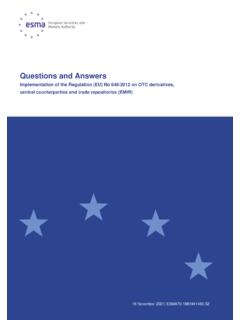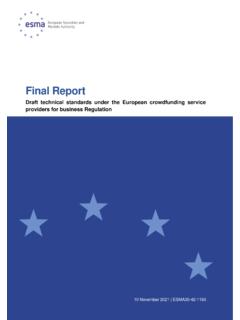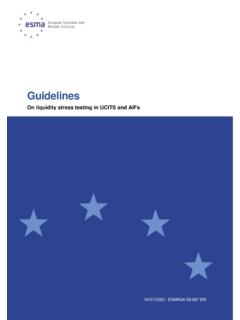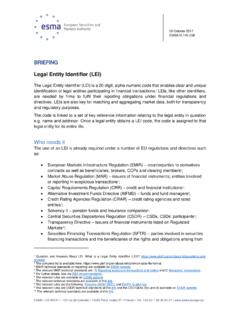Transcription of CESR’s guidelines on the methodology for the calculation of …
1 COMMITTEE OF EUROPEAN SECURITIES REGULATORS CESR, 11-13 avenue de Friedland, 75008 Paris, France - Tel +33 (0)1 58 36 43 21, web site: Date: 1 July 2010 Ref.: CESR/10-673 CESR s guidelines on the methodology for the calculation of the synthetic risk and reward indicator in the Key Investor Information Document 2 Executive Summary 1. CESR delivered its advice to the European Commission on the format and content of Key Information Document disclosures in October 2009 (Ref. CESR/09-949). That advice was supplemented by two detailed technical methodologies on the risk and reward indicator (Ref. CESR/09-1026) and the ongoing charges figure (Ref.)
2 CESR/09-1028) that were delivered in December 2009. The Commission has indicated that it sees these methodologies as being more appropriately adopted via binding technical standards by the new European Securities and Markets Authority (ESMA) rather than as level 2 implementing measures. During the period leading up to the establishment of ESMA, CESR has agreed to adopt the methodologies as level 3 guidelines in order to provide clarity to the industry in implementing the new package of UCITS requirements. 2. The methodology for the synthetic risk and reward indicator (SRRI) set out in these guidelines applies to all UCITS.
3 It should be based on the volatility of the fund using weekly or monthly returns covering the previous five years. In light of the outcome of the volatility calculation , the UCITS should be assigned to the appropriate category on a numerical scale of 1 to 7. The methodology sets out how the volatility intervals should be defined as well as detailed rules on how to assess migrations. There are specific rules on application of the methodology to absolute return funds, total return funds, life cycle funds and structured funds. In the latter case, the SRRI should be calculated on the basis of the annualized volatility corresponding to the 99% Value at Risk (VaR) at maturity.
4 3 Background and introduction 1. In its technical advice to the European Commission on the Key Information Document for UCITS (CESR/09-949), published on 28 October 2009 (hereafter the Advice), CESR proposed the use of a synthetic indicator (hereafter the SRRI) for funds risk and reward disclosure, accompanied by a short narrative description of the limitations of the indicator and, where relevant, the risks that are not fully captured by the indicator. 2. In order to reach this conclusion, CESR consulted twice with external stakeholders, during the spring (March) and over the summer (August and early September) of 2009, and took into account, inter alia, the findings from the Commission s testing exercise.
5 In particular, the testing revealed that investors have a strong preference for the inclusion of a synthetic indicator in the Key Investor Information Document (KID), and that they seem to be more confident in their ability to compare funds and assess their level of risk when they are provided with an indicator based on a numerical scale. 3. However, CESR also acknowledged that a move towards the inclusion of a synthetic risk and reward indicator requires agreement on the methodological elements underlying the calculation of such an indicator. This will ensure that all UCITS funds are classified into the risk and reward scale according to the same criteria throughout the European Union.
6 4. CESR therefore developed a detailed methodology for the computation of the SRRI, which it submitted to the Commission in December 2009 (Ref. CESR/09-1026). In the formulation of its proposal, CESR benefited from the work of both regulators and industry representatives. CESR also published a feedback statement setting out how the responses to the consultation had been reflected in the advice (Ref. CESR/09-995). 5. The methodology was tailored to cover the particular features of the different types of fund and, in particular, to satisfy the following criteria and objectives: provide investors with a meaningful indication of the overall risk and reward profile of the UCITS; ensure an appropriate spread of UCITS across different risk classes; be applicable to all types of UCITS; leave no room for manipulation; enable easy and cost-effective implementation by UCITS providers; be easily understood by auditors, advisers and distributors; enable easy and effective supervision by regulators.
7 And achieve an adequate degree of stability in the risk classification process with respect to normal trends and fluctuations of financial markets. 6. Following submission of CESR s advice, the European Commission began work to prepare the level 2 implementing measures that would support the requirements of the revised UCITS Directive (2009/65/EC) at level 1. The advice that CESR submitted on risk and reward disclosure in particular Section 4 of Ref. CESR/09-949 was incorporated into the level 2 4 implementing measures without any substantive changes to the content. This is reflected in Articles 8 to 9, 29, 32 and Annex II of the KII implementing Regulation1.
8 7. During the preparation of the implementing measures, the Commission explained that the technical methodologies, which it considered formed a central element of the advice, would not be best suited to delivery by means of measures at level 2, but instead as binding technical standards under the new EU supervisory framework. This relates to the SRRI methodology and the detailed methodology for calculating each UCITS ongoing charges figure (on the latter, see document Ref. CESR/10-674). 8. The Commission considers the methodologies an important element in the operation and uniform application of the requirements on Key Investor Information and takes the view that they should be harmonised and legally binding on all UCITS.
9 The Commission has further acknowledged that, due to their highly technical features which are tailored to the current market, it is likely that the methodologies will require work by CESR in the future to reflect developments in the market in an appropriate and timely manner. This will allow sufficient flexibility in monitoring the application of the methodologies over time and appropriate adjustments to be made. 9. Taking these points into account, the Commission decided that it would be preferable to allow the future European Securities and Markets Authority (ESMA) to adopt the methodologies as technical standards in their entirety.
10 In the interim, CESR has agreed to adopt the methodologies as level 3 guidelines . This provides clarity and certainty to the industry for the purposes of implementing the new UCITS requirements as a package. Stakeholders should note that the substance of the methodology itself has not changed and is exactly the same as the version published on 22 December 2009 (Ref. CESR/09-1026). 1 COMMISSION REGULATION 583/2010 of 1 July 2010 implementing Directive 2009/65/EC of the European Parliament and of the Council as regards key investor information and conditions to be met when providing key investor information or the prospectus in a durable medium other than paper or by means of a website 5 methodology for the calculation of the synthetic risk and reward indicator The following calculation methodology should be used by UCITS management companies for the purposes of calculating the synthetic indicator referred to in Article 8 and Annex I of the
